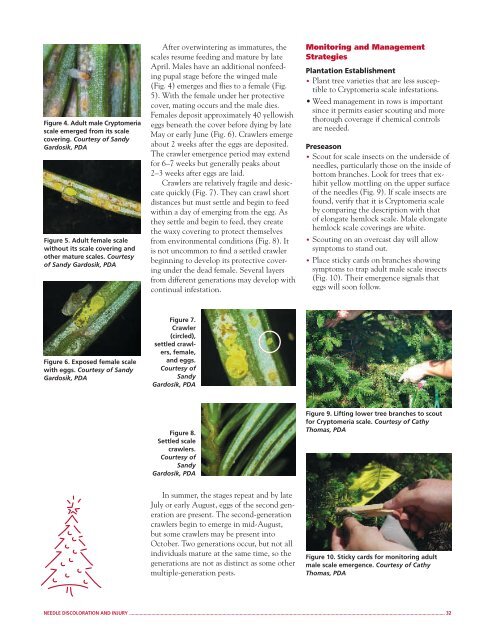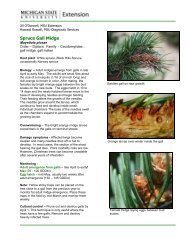Integrated Pest Management for Christmas Tree Production: A ...
Integrated Pest Management for Christmas Tree Production: A ...
Integrated Pest Management for Christmas Tree Production: A ...
Create successful ePaper yourself
Turn your PDF publications into a flip-book with our unique Google optimized e-Paper software.
Figure 4. Adult male Cryptomeria<br />
scale emerged from its scale<br />
covering. Courtesy of Sandy<br />
Gardosik, PDA<br />
Figure 5. Adult female scale<br />
without its scale covering and<br />
other mature scales. Courtesy<br />
of Sandy Gardosik, PDA<br />
Figure 6. Exposed female scale<br />
with eggs. Courtesy of Sandy<br />
Gardosik, PDA<br />
After overwintering as immatures, the<br />
scales resume feeding and mature by late<br />
April. Males have an additional nonfeeding<br />
pupal stage be<strong>for</strong>e the winged male<br />
(Fig. 4) emerges and fl ies to a female (Fig.<br />
5). With the female under her protective<br />
cover, mating occurs and the male dies.<br />
Females deposit approximately 40 yellowish<br />
eggs beneath the cover be<strong>for</strong>e dying by late<br />
May or early June (Fig. 6). Crawlers emerge<br />
about 2 weeks after the eggs are deposited.<br />
The crawler emergence period may extend<br />
<strong>for</strong> 6–7 weeks but generally peaks about<br />
2–3 weeks after eggs are laid.<br />
Crawlers are relatively fragile and desiccate<br />
quickly (Fig. 7). They can crawl short<br />
distances but must settle and begin to feed<br />
within a day of emerging from the egg. As<br />
they settle and begin to feed, they create<br />
the waxy covering to protect themselves<br />
from environmental conditions (Fig. 8). It<br />
is not uncommon to fi nd a settled crawler<br />
beginning to develop its protective covering<br />
under the dead female. Several layers<br />
from different generations may develop with<br />
continual infestation.<br />
Figure 7.<br />
Crawler<br />
(circled),<br />
settled crawlers,<br />
female,<br />
and eggs.<br />
Courtesy of<br />
Sandy<br />
Gardosik, PDA<br />
Figure 8.<br />
Settled scale<br />
crawlers.<br />
Courtesy of<br />
Sandy<br />
Gardosik, PDA<br />
In summer, the stages repeat and by late<br />
July or early August, eggs of the second generation<br />
are present. The second-generation<br />
crawlers begin to emerge in mid-August,<br />
but some crawlers may be present into<br />
October. Two generations occur, but not all<br />
individuals mature at the same time, so the<br />
generations are not as distinct as some other<br />
multiple-generation pests.<br />
Monitoring and <strong>Management</strong><br />
Strategies<br />
Plantation Establishment<br />
• Plant tree varieties that are less susceptible<br />
to Cryptomeria scale infestations.<br />
• Weed management in rows is important<br />
since it permits easier scouting and more<br />
thorough coverage if chemical controls<br />
are needed.<br />
Preseason<br />
• Scout <strong>for</strong> scale insects on the underside of<br />
needles, particularly those on the inside of<br />
bottom branches. Look <strong>for</strong> trees that exhibit<br />
yellow mottling on the upper surface<br />
of the needles (Fig. 9). If scale insects are<br />
found, verify that it is Cryptomeria scale<br />
by comparing the description with that<br />
of elongate hemlock scale. Male elongate<br />
hemlock scale coverings are white.<br />
• Scouting on an overcast day will allow<br />
symptoms to stand out.<br />
• Place sticky cards on branches showing<br />
symptoms to trap adult male scale insects<br />
(Fig. 10). Their emergence signals that<br />
eggs will soon follow.<br />
Figure 9. Lifting lower tree branches to scout<br />
<strong>for</strong> Cryptomeria scale. Courtesy of Cathy<br />
Thomas, PDA<br />
Figure 10. Sticky cards <strong>for</strong> monitoring adult<br />
male scale emergence. Courtesy of Cathy<br />
Thomas, PDA<br />
NEEDLE DISCOLORATION AND INJURY ................................................................................................................................................................................................................................................ 32





